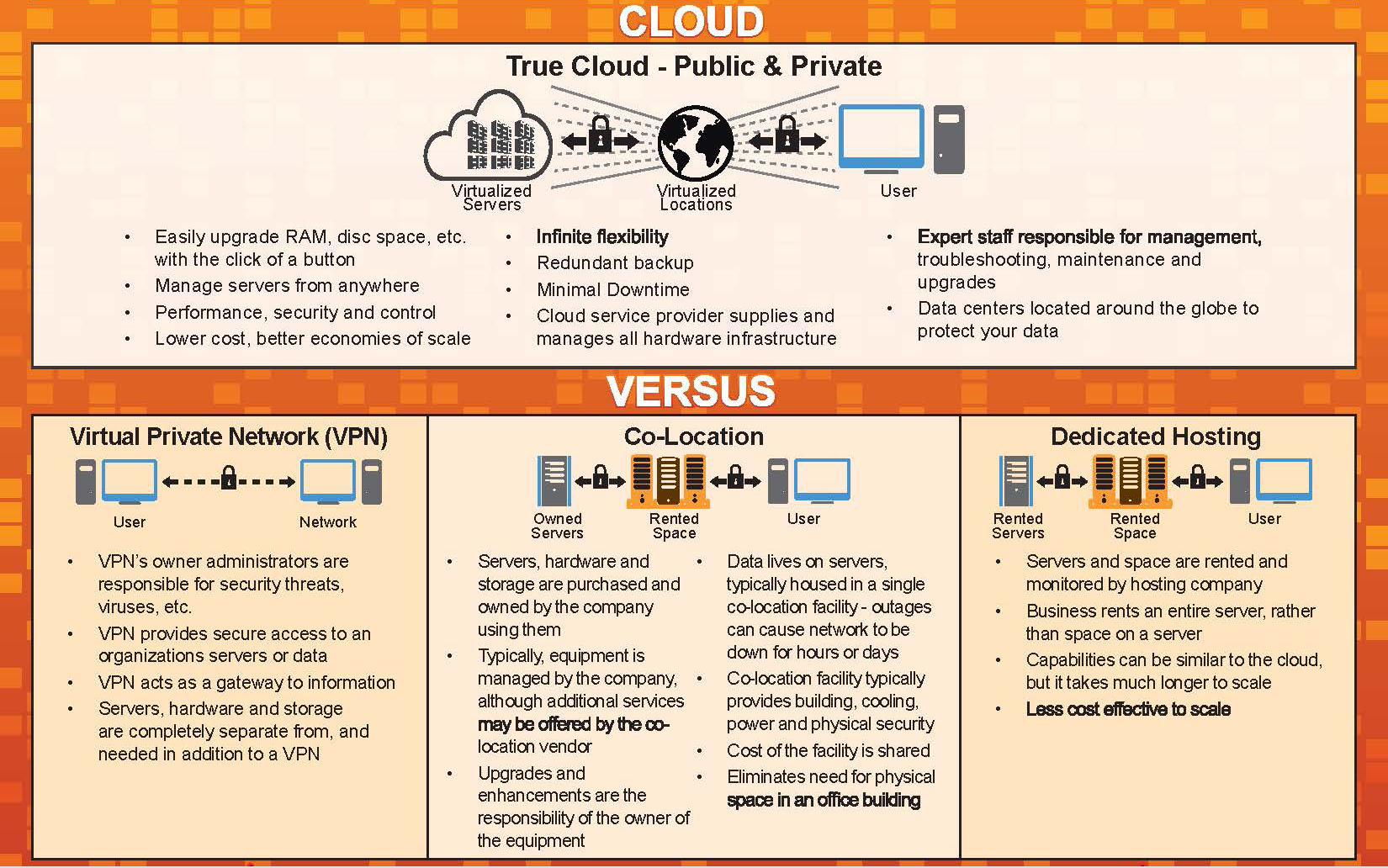True Cloud, Hosted, and Co-location Services Defined
Just because you can access information online doesn’t mean that information lives in the cloud. If your technology provider claims to be cloud-based but isn’t, you could be facing threats such as slow server speed, high costs of the infrastructure being passed on to you, downtime, or the ultimate nightmare – complete catastrophic data loss.
Our goal is to explain the difference in technology between true cloud computing as opposed to other means of server management.
True Cloud – Cloud-based infrastructure services can save costs by using a shared facility. The difference between cloud and co-location is that the cloud provider owns and manages the servers, storage and the facility itself. Cloud services offer the flexibility to be able to scale almost instantaneously based on business needs. It also keeps IT resources free from having to manage the hardware and lets the experts focus on their core competencies – managing the equipment and security. Reputable cloud providers will have compliance and security certifications as well, to protect your data. Cloud services enable companies to have the convenience and security of multiple data centers without the cost of the buildings and maintenance. Downtime is virtually non-existent because data is stored and backed up on multiple servers around the world. The cloud is resilient and redundant. Another benefit of the cloud is that it can be managed from anywhere – installation and management of servers and software can be done remotely. One of the best thing about cloud services is that they can be customized with the click of a button. For example, you can automate top-notch firewalls and security controls, data protection and compliance measures based on your business needs. Redundancy on power supply and data backup ensures your data is safe. In the unlikely event of an outage, the cloud provider will migrate all the data to another server without downtime.
Dedicated Hosting – This is the next closest option to a true cloud solution. Servers and space are rented and monitored by a hosting company but it is less cost-effective and more time-consuming to scale. This is because the client leases an entire server and when they need a new server, they will have to plan ahead for lease and installation of that server. Hardware failures can also be an issue since all of your data is on a single dedicated server. Oftentimes dedicated servers are running on a single power supply too, so if there is an electrical outage and generator failure in the location where your servers are stored, you’re out of business until it comes back up. In a dedicated hosting environment you run the risk of running on old, outdated hardware depending on how often the facility purchases upgrades.
Co-location – Organizations purchase and own their own equipment including servers, storage, switches, and software. They also manage, maintain and monitor their equipment. The organization rents space in a co-location facility such as the Switch Data Center (formerly known as Supernap) to share some of the costs with other companies. Some co-location facilities offer managed services that can free up IT resources, similar to those offered with dedicated hosting or cloud services. Any upgrades will be the responsibility of the organization, and can be very time-consuming and costly, especially when replacing hardware. Backups, data security, and downtime can become problematic as server space is limited only to that which is owned by the organization.
VPN – A Virtual Private Network, or VPN is a tunnel that enables users to send and receive data across networks. It is a gateway that typically allows authorized remote users to log into a network by way of passwords, biometrics, etc. A VPN is owned and managed by the business using it and is an inexpensive way of creating a private network environment. Concerns such as bandwidth, performance issues, and speed are still reliant upon the servers, firewalls and other equipment a company owns or leases. The VPN is not a computer or a server, it is simply an added layer of authentication.
In-House Data Center Storage – Several companies have moved away from storing their own servers because of space constraints and the cost of upgrading and maintaining their own servers. If an organization chooses to own, use and maintain their own equipment within a facility they own, this is called an in-house data center. Another reason companies have moved away from this model is that it can be costly to build and maintain additional space when new servers are needed due to the cost of cooling, racks, power, and overall space. This is why some companies opt for a co-location facility.
PawnMaster’s new true cloud-based product, Ignite brings a new level of flexibility and security to the market. We know cloud isn’t for everyone, though. For instance, we understand some shops are located in more rural geographies where internet access can be unstable. In a case like this, a cloud-based solution wouldn’t be the answer for this customer. This is why PawnMaster will continue to support their windows-based product as well. No matter what your needs, we have you covered.
{{cta(‘a7d35ae5-02d9-4077-a966-0871581c4bd5’)}}
The cloud has been a hot buzzword over the past few years, but let’s be honest, what do we really know about it? What is it, and how does it work? How does it impact you? What are some inherent risks and challenges it has faced over the years and does your business really need it?

